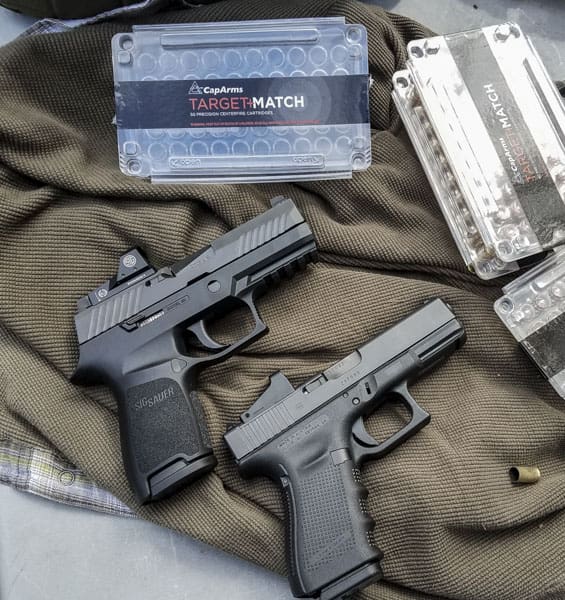
Using an Aimpoint on my M4 in combat taught me many real world lessons on the advantages of a red dot over traditional iron sights. That said, when it comes to handguns, I’m an iron sights kinda guy. None of my pistols have a red dot, not even those made to take one. As red dots have gotten smaller, lasted longer and become much more rugged, I figured the time had come to try one out for an extended period . . .
As luck would have it, RF needed someone to put the new SIG SAUER P320 RX head-to-head with the established GLOCK 19 MOS with a JP Enterprises JPoint reflex sight. On paper, both of these guns are extremely similar. As equipped, they’re within a Benjamin of each other. In the hand, however, they’re as similar as apples and bowling balls.
Although they appear identical and are similar in execution, they’re very different when you shoot with them. I shot each pistol through each stage of this comparison side-by-side. I put 50 rounds through both for familiarization at the 10 yard line and then got out the timer. What a humbling experience.
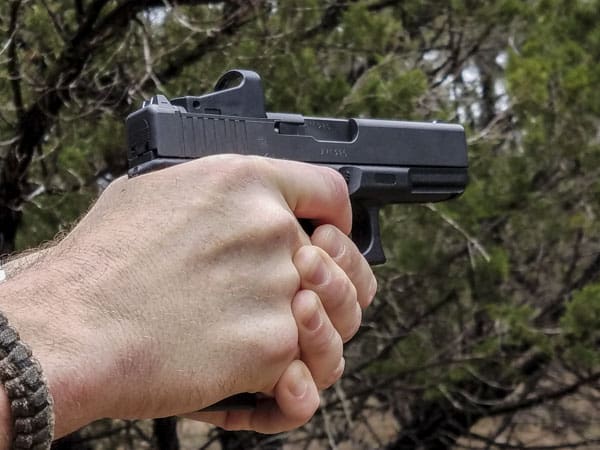
I always feel like I have to point a GLOCK downward to get the sights on target. Drawing the GLOCK 19 MOS with the red dot increased that sensation. Even though the dot and the sights were correctly co-witnessed, I was still looking through the top of the optic, effectively pointing the gun at the horizon and searching for the dot.
With my EDC 1911, I’ve been averaging 1.10 seconds to draw and fire into an eight-inch circle at 15 yards. I get a few sub-one second draws in there, but I’m usually just over that.
My first series of shots with the G19/JPoint combination ran closer to 2.5 seconds. It was very confusing. I felt like my hands were doing the right thing, but my eyes just couldn’t find the sights. After 100 rounds, I ended at a two-second draw and strike time. Time to switch to the P320RX.
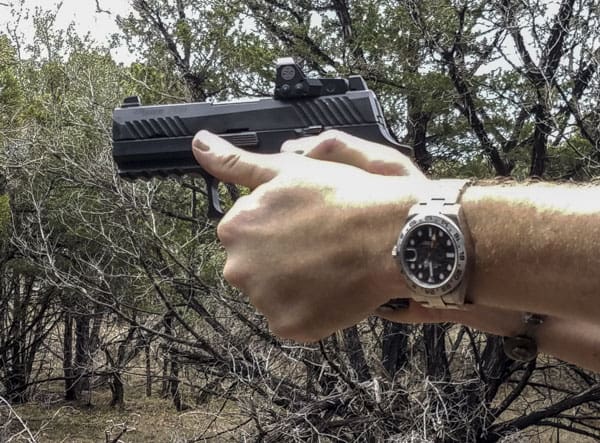
You would have thought — I certainly did — that I’d have started where the G19 left off, but you’d be mistaken. It was like starting all over again. Heck, it was like learning to shoot all over again.
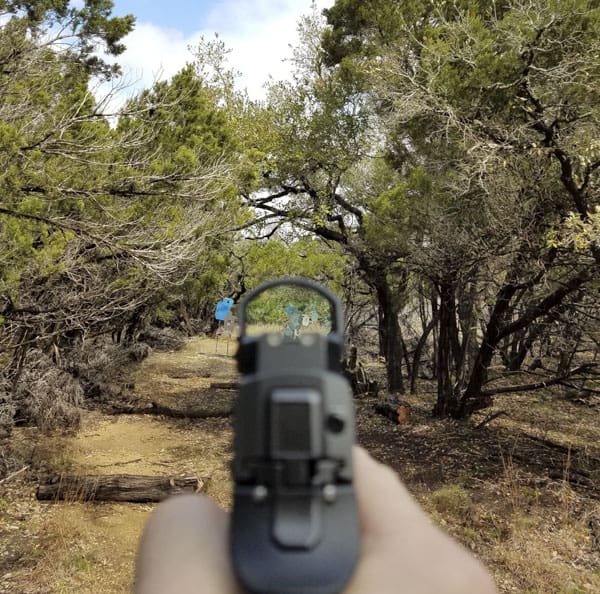
The SIG Romeo sight is considerably larger (both wider and taller) than the JPoint. That’s to give you more view of your target while you look through the sight. But that also means there’s more real estate for that dot to hide in, until you have the gun in line with the target.
I was actually slower initially with the P320 RX than I was with the G19/JPoint. But after about 100 rounds, this one settled down to about the same draw and strike time.
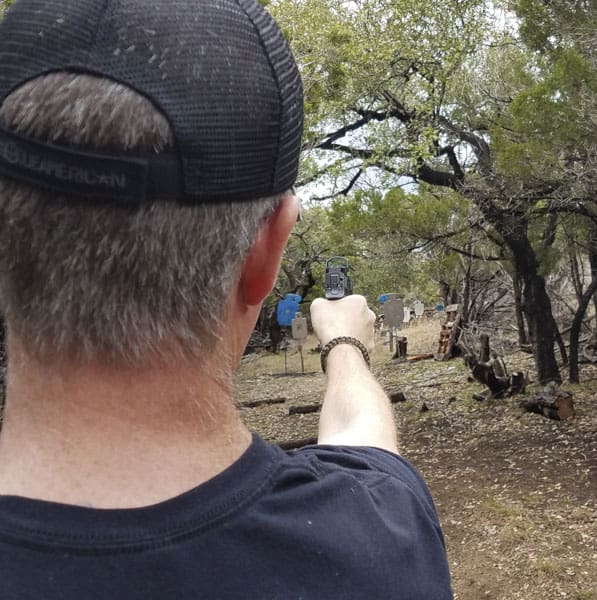
I spent more of my time with the next set-up. I placd a steel silhouette with a 4X6-inch center plate at the 15 yard line and timed my draw and strike with two, three, and five rounds. I spent a few days on this drill, sending a full 500 rounds downrange, trying to get used to really seeing the dot when I pressed the gun forward.
For each pistol, my times steadily went down as the round count went up. Although the guns felt entirely different in my hands, they performed with shockingly similarly.
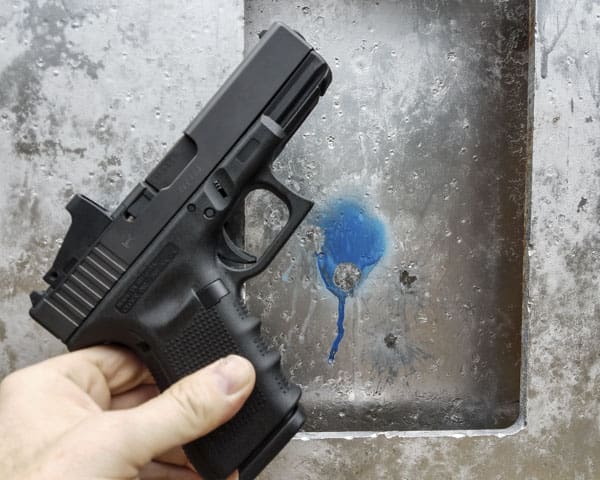
If I had not had the timer with me, I would have sworn the G19/JPoint combination was faster than the P320RX. I would shoot 50, average the scores, then switch guns and repeat, until all 250 were done. The difference between my draw and strike time between the guns was never more than 2/10th of a second between the guns in any group.
What is really surprising: my first and second shot split times. On average they were .17 of a second for the GLOCK and .16 for the SIG. Yup, a whopping 1/100th of a second. My total draw and strike with two with the Sig was 1.91, with a draw of 1.75 and a second shot .16 of a second later.
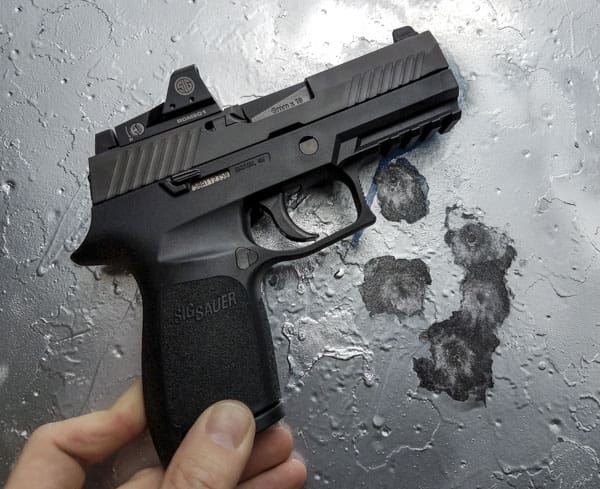
For the GLOCK, that total time averaged to 1.84, with a draw of 1.67 and a split time of .17 of a second. Although my draw time varied a bit for both guns, with a slightly wider standard deviation with the P320RX, the split times of .16 to .17 is extremely consistent throughout both guns. Pulling out my log from my training with my EDC, I had recorded a .17 split time, with iron sights.
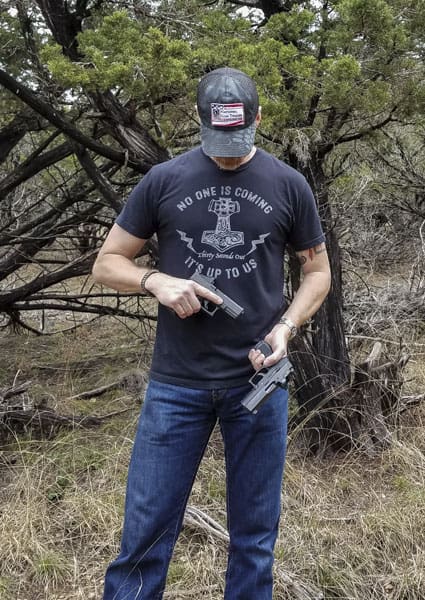
What’s to learn from all this? It seems pretty obvious that, once my sights are on target and my hands are in the right position, I’m shooting consistently and it doesn’t matter what sight I’m using, I’m bring the gun down in recoil the same and firing the same no matter what. The variation is that first round out.
Although they are so close as to be practically meaningless, the slight edge to the G19/JPoint comes down to the smaller window. Or specifically, the shorter sight window. I naturally want to look down the middle of the optic, but both of these optics place the red dot closer to the bottom than the middle. As the Romeo has a taller sight, I’m moving it down a little bit more than the JPoint to see it. I seem to be looking for it with my eye a tiny fraction of a second longer. But really, only a teeny tiny fraction longer.
At the 10, 15, and 25 yard lines, I didn’t see any improvement with the red dot when it came to accuracy. In fact, up to the 15 yard line, I was more accurate with the iron sights. At 25 yards, I was just about even. Push it out to the 50, though, and things radically changed.
With the G19/JPoint, my standing slow fire 50-yard five-shot groups were about 5 1/2 inches. With the P320 RX, they were 5 inches. That level of accuracy is what I would expect shooting with iron sights off of bags.
What’s really cool: those groups didn’t change much when I went to single-hand shooting. That’s something I just can’t do with traditional sights with a G19, certainly not with any consistency. Without worrying about lining up three planes, the red dot floating right over the target let me focus much more on my trigger squeeze. So the red dot was definitely a help in long-range accuracy, but neither gun was any better than the other.
Beyond long-range accuracy, another advantage of the red dot, at least for me, was firing with my weak hand. I’m horrible with my left hand. First, the tendons of my thumb and first two fingers on my left hand have been cut, making them a little slower and weaker, and I’m extremely right eye dominant.
Shooting normally, I keep both eyes open with no problem, I always have. Shooting left handed, I have to close my right eye if I want to hit anything. If I don’t, I’m likely to miss a silhouette entirely at 25 yards. But using either of the red dots I have the same accuracy with both eyes (or either eye) open. Tactically, that’s an advantage, even if using it is rare.
In the end, I’ll still stick with traditional irons on my EDC guns. I don’t see the need to drill with another piece of equipment until it’s as good as what I’ve already got. The long range and single-handed advantage I get from the optic just doesn’t sell it for me.
But that didn’t surprise me. What did surprise me: how similarly the two guns, both of which felt very different in my hands, performed. Yet another example where the target and timer don’t lie, but my perceptions certainly did.
GLOCK G19 with JPoint (https://us.glock.com/products/model/g19) (http://www.jprifles.com/1.6.1.php)
Draw and strike time: 1.67
Draw and strike two rounds time: 1.84
50 yard standing group: 5.5 inches
SIG SAUER P320RX Compact (https://www.sigsauer.com/store/p320-rx-compact.html)
Draw and strike time: 1.75
Draw and strike two rounds time: 1.91
50 yard standing group: 5 inches




Very nice review JWT, Stands out from the crowd for sure on topic and execution.
Thanks.
Outstanding review. As Ken mentioned below, I would like to see some feedback from some of us older guys following Jon’s process and this concept. I’m about to turn 50, and my eyes are not what they used to be – the front sight is getting harder to find and keep in focus. I’m considering one of these to put a Deltapoint or RMR on, and then see what the target and the timer say. I’ll keep training with irons and shoot even more, but I’m all for using something that will help offset some of my diminishing capabilities.
I haven’t had a ton of experience shooting with red dots on handguns. I have shot a friends 34 MOS with a Trigicon on it (not sure what model). My experience was similar, it seems like you really have to angle down to pick up the dot. However like everything else firearms-related, practice and drill make perfect and this would be no different. Once you’ve acquired the dot and gotten somewhat used to it though, it’s great.
Like JWT, I tend to prefer to just use the irons on a handgun. I don’t shoot in any competitions, so handguns are simply for self-defense or range plinking. While I have scopes and red dots on all of my rifles, I always prefer to have irons as well. I’ve never liked how hunting rifles are made without irons anymore; sure you’ll likely never use them when on the hunt, but it would still be nice to have.
Either way, nice write up. While I carry a 19 daily, I do prefer the sights on the 320 over the 19.
It would be interesting to see what you could do with a 1911 equipped with a red dot if such a thing is possible. The different in times may be the pistol and not the sight.
Such a thing is most definitely possible.
https://stiguns.com/guns/dvc-open/
Open division pistols are very commonly 2011/1911 style guns, in USPSA/IPSC/3 Gun/Steel Challenge
However, 2011/1911 style guns often have the red dot frame mounted.
Also, Nighthawk now offers at least one model with an RMR…
http://www.nighthawkcustom.com/pistols/1911s-government/shadow-hawk-government-rmr
It seems like irons are actually faster from a draw and up close, which is the exact opposite of a long gun.
I had the same thought. I think the fact that the cheek-stock position is so repeatable, which fixes my eyes in one place for the rifle, makes a big difference in how fast I pick up the red-dot. The pistol doesn’t have that fixed eye position, so I am searching for the reticle.
I’m confused… You said the dot and irons were “properly co-witnessing”, yet you also say you were searching for the dot? Have you ever tried a red dot setup done right from Suarez? The idea is to mount the optic as low in the slide as possible (the MOS definitely does not accomplish that), and co-witness with suppressor-height sights. Then you don’t search for the dot, you pick it up as you are aligning the irons.
Also, here’s a tip from Haley:
https://youtu.be/6ULnzq0DIww
I’m confused… You said the dot and irons were “properly co-witnessing”, yet you also say you were searching for the dot?
Doesn’t sound like you are confused at all.
If they are properly co-witnessed, you should not be searching for the dot. Just use the irons and then switch to the dot if you want/need to.
I doubt the MOS is properly set up. Don’t know about the Sig, but if you posted a picture looking through the optic with irons aligned it would help clear it up.
All I know is that nobody who has it set up properly ever talks about “searching for the dot”.
This was my experience as well. Tried my first dot a .22Rf semiauto pistol. Slow and bulky. No improvement in short range accuracy, but slower. Thought maybe some familiarity would help. I had planned on shooting the whole brick but before I got to the 500th round I wasn’t getting much better and was still behind irons.
Switched it out to a 10/22 and had no problems. Faster off the mark, and more accurate as well, although not noticeably so until longer range(50 or so).
The extra bulk wasn’t noticeable, even on a small rifle, and so I adopted a policy of; irons for handguns/dots for CQB rifles/real optics for longer range rifles. Years later somebody had a Saurez gun at the range that I got to try. He swore up and down that it would do everything but butter your toast in the morning.
I found no reason to change my policy. The high sights did make the dot easier to pick up(still no better than irons tho), but the increase in bulk I found unacceptable. I don’t consider an inch better group at 50 to be of much use to me. I can hit a full size silhouette at 100. Just how much more does a guy need? When is a handgun ever going to be used at 100 anyway, short of the range for a challenge, or certain games that require it?
Diggin’ the Mjölnir shirt.
Sál fullr tor hjärta líkr stál min bror.
https://thirtysecondsout.com/
Good stuff, ty for link.
As I get older, I find that getting good hits with my iron-sight pistols gets way harder. So, for home defense I keep a couple of ARs with red dots on them.. it’s the most ergonomic choice for me all around. For carry, I will probably stay with iron sights because I can still get fast paper-plate hits up to about 15 yards.
So are you 65 years old? Maybe get someone with aging eyes to do the same thing.
BTW nice gun kata in that last pic.
Well honestly, when it’s that tight between the two it sounds to me like both guns are functionally equal in terms of accuracy and draw time. Outside of, perhaps, competition shooting. And even then I think some of that would provably even out with more practice.
Try shooting the rimfire challenge with a red dot and open sights, the red dots dominate our local matches.
“The SIG Romeo sight is considerably larger (both wider and taller) than the JPoint. That’s to give you more view of your target while you look through the sight.”
That isn’t how this works, this isn’t how any of this works.
Unless the optic has large obstructions (like a traditionally mounted Cmore) the size of the window doesn’t really give you a better view of the target if you are shooting with a proper two eyes open target focus. The other eye will fill in the gaps that are obstructed by the frame of the optic. Heck that was how the original red dot sights worked, they didn’t even have an objective lens and relied on the brain to super impose the dot on the target as seen by the other eye.
The good folks at Sig would disagree with you, to quote their ad, “The ROMEO1 provides a massive Field of View compared to other reflex sights in its class, giving you surprising advantages with its miniature build.”
I’m not a Glock-hater by any stretch, but I’ve found the trigger on the full-sized P320 to be better than the Glock, especially for follow-up shots. Nothing like that noticed here?
The guns feel very different in many ways, the trigger being one of them. The Glock felt like it pointed better, the Sig felt like it was faster on follow up shots.
And yet, neither was true. Feelings lie, the timer tells the truth.
A gentlemen shooting a 320 at our range allowed me to shoot it some. Compared to a Glock, even with a quality connector, I was WAY early on the trigger initially. For a striker fired gun, it was shockingly short and solid. I was really surprised. He was a shameless ambassador for the 320 – he was skeptical at first, but he loves it. I’ll have to give the 320 some range time and see how I like it.
“I’m extremely right eye dominant. . . . Shooting left handed, I have to close my right eye if I want to hit anything.”
JWT, if you let the pistol cant a bit, like gangsta-style but not as extreme, you will have no problem shooting left handed while aligning the sight with your dominant right eye.
It shouldn’t work, but it does, at least for me. Anyway, it’s worth a try.
Thanks, I’ll give it a shot.
Not sure about the guns, but I gotta respect the Explorer II.
I couldn’t recommend it more. I’ve put it through absolute hell and it keeps running great.
Started using a redot in 2001 on my G19, then added on onto my G35, then one on my 10 mm. Sold all my glocks, now have a burris on my STI Ranger 9 mm. Even when my eyes were still strong, the dot was faster, now that I’m bi- focal its a must for accurate shooting.
Just curious. Do you ever NOT start a piece be mentioning how you were in combat?
Use the search function. In the last 20 articles I included it in the opening once, and (in comparing my issued Colt M4 to my Colt Competition Rifle), one more time. So that’s 2 out of the last 20 that I mention my service, and only one that mentions combat.
Feeling inadequate?
I use a g19 with a red dot for uspsa. The secret to red dots on pistols is this:
The reticle makes for faster target transitions and if you practice faster follow ups. Irons are faster on the draw, so you just need to draw the gun and use the co-witnessed irons for the first shot. As you do this, the red dot will come into view and you can shift your focus from your front sight to the target, where the dot will be. It is shocking how huge a difference doing this makes.
Neat, I’ll give it a try. Is there any trick to finding the front sight in the clutter of the mount?
If you are asking that question, it definitely sounds like your optics are too high and/or sights are too low.
Take a look at the picture in this article:
http://blog.suarezinternational.com/2017/02/the-suarez-v-5-slides.html
I went back and zoomed in on your picture of the Sig to see the dot. I don’t think you understand what I mean by properly co-witnessed. Those sights are definitely too low and the optic is too high. The dot should be sitting just above your front sight, or in some installations once zeroed it might actually be covering the tip of the front sight.
No I understand, that’s exactly where they are. A 6 o’clock front sight picture stikes the same as a center hold on the dot, leaving the dot immediately above the front sight. But with either mount, there is a lot of clutter with the mount, front sight, and rear sight. It makes iron sight alignment slow and very difficult for me to transition back and forth from.
Ok, that’s not what it looks like in your picture but I’ll take your word for it. I think your main problem may be that for both setups the optics are just not low enough. That’s the problem you have when you try to design the setup to handle multiple options and have to use up space with adapters. If you use a slide that has been milled for a specific optic you can get it lower which may address your issues.
You ought to do a review of a Suarez International setup and I’m sure Gabe would be happy to explain to you why he thinks it should be done the way he does it.
I would bet that if you take a pistol that you train with often, that you can look at the target- close your eyes, draw the pistol, and when you open them the sights will be very close to aligned. This makes finding the irons not hard.
I also use blacked out irons to reduce clutter.
I have always trusted SIG. If I had to, I believe I could learn to trust Glock.
But, call me old fashioned, I’ve never felt comfortable turning my life over to anybody’s Energizer Bunny.
Has anyone seen my batteries?
You are not trusting your life to a battery. In something like the Trijicon RMR, the batteries are supposed to last up to 2 years. And even if your battery is dead, you still have the irons you have used your whole life sitting there waiting to be used the same way you always have used them.
Comments are closed.